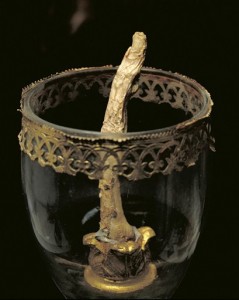Officials of Florence’s Istituto e Museo di Storia della Scienza (Insitute and Museum of the History of Science) announced Friday that Galileo Galilei’s right thumb, index finger and a tooth, missing since 1905, have been found.
Three fingers, a tooth and a vertebra were removed from Galileo’s body by science historian and naturalist Giovanni Targioni Tozzetti in 1737, 95 years after Galileo’s death. By then the Church’s case against Galileo had been weakened by a century of heliocentrism, and after fruitless decades spent lobbying the Church by his disciples and the secular authorities of Florence, the last Medici Grand Duke flexed his muscles and erected a proper memorial in consecrated ground for the great man.
In a solemn ceremony witnessed by many prominent Florentines but no ecclesiastical authorities, Galileo’s body was moved from a non-descript storage area to the memorial tomb in the Basilica of Sante Croce, across from Michelangelo’s tomb. When the casket was opened, Tozzetti whipped out a scalpel and removed the fingers, tooth and veterbra. In his account of the event, he admitted he was sorely tempted to “take away the skull which had housed such extraordinary genius.”
 The middle finger went to the IMSS shortly thereafter. The vertebra went to the University of Padova, where Galileo taught for 19 years. Both institutions have carefully preserved their Galilean remnants ever since. The thumb, index and tooth were claimed by Marquis Vincenzio Capponi, a prominent Florentine from an old family who was one of the witnesses to the reburial.
The middle finger went to the IMSS shortly thereafter. The vertebra went to the University of Padova, where Galileo taught for 19 years. Both institutions have carefully preserved their Galilean remnants ever since. The thumb, index and tooth were claimed by Marquis Vincenzio Capponi, a prominent Florentine from an old family who was one of the witnesses to the reburial.
The Capponi family placed the remains in a blown glass vessel which they later encased in a wooden box topped with a bust of Galileo. Over the generations, the Capponi descendants lost track of what the box contained, and they sold it. It passed through various hands until it disappeared from the record in 1905.
It popped up again at a recent an art auction, listed as unknown human remains in an 18th c. blown glass vessel encased in a 19th c. wooden box topped with a bust of Galileo. A collector bought it, researched it thoroughly and found that it matched the description of the Capponi Galileo reliquary. The collector then contacted the IMSS and donated the remains anonymously.
The museum will take a sample and DNA test it to confirm the identification of the fingers and teeth, but scholars are convinced from the documentary evidence that these are in fact the missing Capponi relics of Galileo. The case and contents match the descriptions of the Galileo artifacts in historical documents. Somebody along the way could have removed Galileo’s bits from the case and replaced them with some random body parts, of course, but the remains match the known ones so that seems unlikely.
The finger and tooth will go on display next Spring when the museum reopens after renovation with a new name: Museo Galileo, the Galileo Museum.
To learn more about Galileo and browse the other Galileo-related items on display at the museum, go here.
At least some more info on this than what the newspapers over here are telling (in most cases they don’t even bother reporting).
Yeah, unfortunately papers often just carry the wire service story, which is vague and sometimes inaccurate. The AP, for instance, says the two missing fingers were thumb and middle, when they’re actually thumb and index. The middle finger is the one in the picture, and it’s been in the museum for 300 years.
so cool so cool so cool. :boogie:
I love, and never fail to cringe at, stories like this where somebody had the stuff without really understanding what they had and so sell it under some nondescript heading to somebody that actually researches it and makes good. Pretty nice of the person to donate the body parts, I was a bit surprised at that.
Also, how friggin’ macabre is that finger in a cup? Seriously. 😆
I was surprised the collector was so generous too. It would have been an easy thing for him to keep it hidden from the world like Gollum with a Precious.